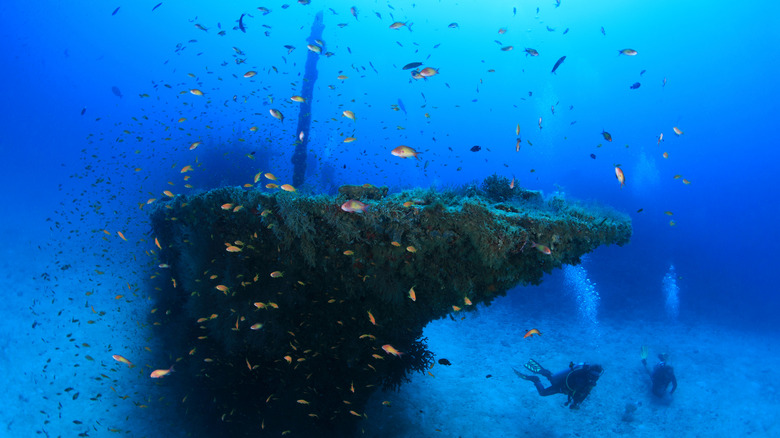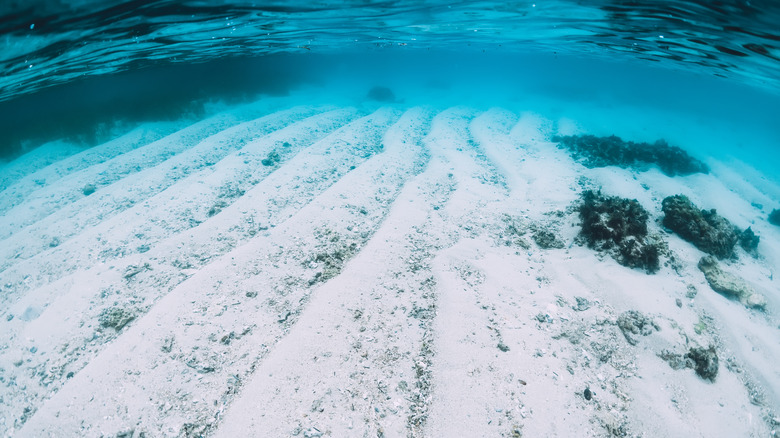Tucker's Cross: The Centuries Old Emerald Cross Lost To Time In The 1950s
When a story starts with a guy named "Teddy Tucker," you can bet it's only to get more ridiculous and fun from there. According to the fairly extensive and surprisingly high-class Teddy Tucker website, Teddy — who died in 2014 — was "a walking encyclopedia," "a master of every discipline having to do with history and the ocean," "one of the great autodidacts in the history of science," and "knows the ocean and everything about it better than any man I have ever seen." While such radiant praise sounds a bit over-the-top and makes it sound like Teddy outstripped Leonardo da Vinci as a grand master of all disciplines, it's true that Teddy combed the seas and was very knowledgeable. He did lots of diving, and found a curious artifact in 1955 in the ocean near Bermuda that gets its name from him: Tucker's Cross.
Teddy wrote about his life and experiences in his 2011 autobiography "Treasure! A Diver's Life," available in full on his website. The book features Tucker's Cross on the cover — Teddy's biggest find — and contains a map and descriptions of his other finds, predominantly shipwrecks around Bermuda. Tucker's Cross is an ornate, gold, emerald-inlaid cross which seemingly belonged to "a Spanish treasure fleet," per his website's Tucker Cross page. The cross sunk in 1594 along with a stash of riches aboard the San Pedro. And sometime after Teddy found it, the cross went missing.
Honest-to-goodness sunken treasure
The Tucker's Cross page on the Teddy Tucker website recounts the story of how Teddy found Tucker's Cross back in 1955. According to Teddy, he'd specifically set out to find sunken treasure in shipwrecks, a task usually reserved to live-action film stars and pieces of fiction. He very simply states, "I was going to go look for treasure — there was no question about that. And then to make a living I bought an old boat and fixed it up — the ability to be out there on the ocean and looking in the reefs when the weather was suitable — and I started finding a lot of shipwrecks."
As the tale goes, Teddy made contact with "local fishermen" who passed some information to him about what looked like a pair of marble columns sticking out of coral reefs around Bermuda. Teddy made a trip out with a fisherman, strapped on his flippers and diving gear, jumped in the water, and found what he thought was the end of an old-timey canon in the sand. Teddy didn't investigate further, and didn't go back until four years later in 1955 "with nothing better to do." He estimated that in another 25 to 30 years the site would have completely covered by sand. At first Teddy uncovered nothing more than debris, like fragments of wood and porcelain. Eventually he found some buttons made from pearl and gold, small gold ingots, a 36-oz gold bar, and Tucker's Cross.
An object of international attention
Pictures of Tucker's Cross on Teddy Tucker's website shows that it existed and was apparently 100% legit. It was inlaid with emeralds and not glass, because the glass would have gotten frosted over time. The cross held seven emerald balls and little rings on the arms, presumably signifying the nails in Jesus' hands during his crucifixion. The craftsmanship, however, was less than stellar. Most likely, the cross was made in the New World rather than back at a jeweler's in Spain. Tucker's Cross — plus the other finds at the site — came to be known as Bermuda's Crown Jewels.
Teddy got international attention for his find and got printed up with pictures in Life Magazine and other publications. There was of course disagreement over the ownership of the cross — likely a piece of jewelry for a bishop — because the waters around Bermuda belonged to the British Crown Estate. U.S. Ambassador to Italy Clare Boothe Luce was also interested in the piece and offered Teddy $100,000 for it. He refused, she countered with $200,000, and he refused again. Luce by all accounts got a bit annoyed with "some young diver from this little island," as Teddy's daughter, Wendy Tucker, described him, and even sent a representative to continue making Teddy offers. Eventually, Teddy he sold the cross to the Bermudan government for £35,000, and it was put on display in an aquarium. The decision to conserve the piece ironically led to its mysterious disappearance.
A heist, a forgery, and the queen
Here's where the tale gets a bit sketchy and veers into Nic Cage movie territory. The Teddy Tucker website says that Queen Elizabeth II visited Bermuda in 1975, and her itinerary included a visit to the Bermuda Maritime Museum at the Royal Naval Dockyard to see Tucker's Cross and the so-called Bermuda Crown Jewels. The Royal Gazette confirms that the queen opened the museum in 1975, and Bermuda Attractions notes it became the National Museum of Bermuda in 2009.
In a scene that might have gotten embellished over time, Teddy Tucker himself welcomed the queen to the room in the museum that held Tucker's Cross, as the Bermuda Crown Jewels page on Teddy's website recounts. Wendy Tucker, Tucker's daughter, was present on the day and described her father's mortification when he escorted the queen to the cross. Somewhere along the way, the original cross had gotten swapped for a fake cross with gold paint that wasn't even dry. Three people helped put the cross on display, but whether these three people were involved in the theft of the cross — or were simply too frightened to speak up — is unknown. No one knows what happened, and Tucker's Cross remains lost to this day.
As it turns out, the allure of sunken treasure might have proven too much for certain people. Other pieces of the Bermuda Crown Jewels went missing in 2005, including a gold ingot from the San Pedro, the same ship that held Tucker's Cross.



